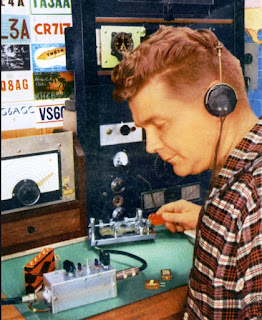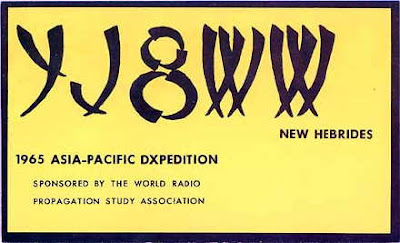 Here Comes The Spring ‘BR’ (Bug Roundup)
Here Comes The Spring ‘BR’ (Bug Roundup)
The upcoming ‘BR’ will be upon us shortly (more details later), but the pending activity brought back some of my early ‘bug memories’ and the good times as a young ham.
I first learned CW in Boy Scouts at age 12 and was pretty excited since I had been shortwave listening by then for about three years ... finally I was going to know what all those dots and dashes I had been hearing were all about!
Unfortunately, to no fault of our well-meaning Scoutmaster, we all learned it the wrong way ... from ‘flashcards’. This made the learning curve a lot harder but in a few months I was copying code off the air and discovering the exciting new world of amateur radio.
By the time I was old enough to legally get my licence (age 15), I could comfortably copy 40wpm and had no trouble with the required 13wpm test.
Having taken the test day off school for the exam and to travel to downtown Vancouver on the bus, there was nobody in the city happier than me when I walked out of the almost five hour exam as ‘VE7ANP’!
Back then, in ‘63, the exam consisted of five parts and a ‘pass’ was required for all of them or you were sent packing for 30 days. The CW receiving test required 100% copy at 13wpm, with the same speed for the sending test. I think it was for three minutes. Next was a multiple choice test on regulations that consisted of about 50 questions. The fourth section required the (unaided) drawing, in schematic form, of a crystal controlled two-stage transmitter, a simple superhetrodyne receiver, an A.M. modulator, a full-wave power supply, some form of over- modulation indicator and a key-click-filter. The final section was an oral exam, as the examiner made you explain your circuit drawings while he probed with questions that were designed to trip up innocent kids that had foolishly ventured downtown.
There were two radio inspectors in the office back then, but getting one of them in particular, was the equivalent of drawing the proverbial short-straw ... ‘old man Baxter’.
He was a giant of a man, standing well over six feet tall, suspender-laden with a jowly face and saggy pants ... along with the growl of a drill sergeant. I quickly realized that I may have been better off staying in school that morning, as OM Baxter was sitting behind the desk, waiting for me, when I shakily opened the door marked ‘RADIO EXAMINATIONS’.
As it turned out, the OM loved CW and when I breezed through the CW tests with no glitches and speed to spare, his rough edges vanished as he seemed to warm up to me. I learned later that almost all prospective examinees failed the CW test miserably on their first go and were given a 30 day time-out ... it seemed that my Boy Scout days were paying-off in spite of the numerous mid-winter rain-soaked Scouting equivalents of the Bataan Death March, that put me off of camping for the rest of my life.
For the first several months on the air, I used my venerable old brass handkey that I was very comfortable with. I only wish that my hand-sent CW was as good today as it was back then ... something I should really work on again. Although I could send at a fairly good clip, it wasn’t long before I was working a lot of guys that were sending even faster, with their bugs. Back then, electronic keyers were just starting to dribble onto the scene and most CW diehards were using a Vibroplex, and boy did they sound great!
One of the popular radio-joints of the era was ‘R-P’ (Rendell-Parret Electronics) on 4th Avenue, started by Hedley Rendell, VE7XW and Bill Parett, VE7AM, who lived above the store. For many years on Tuesday nights, Hedley hosted the Vancouver Amateur Radio Club’s ‘Code and Theory’ class in his basement rec-room. The class was taught by a very kind and gifted teacher, Al Erdman, VE7AQW, the radio engineer for local AM powerhouse, CJOR, in Vancouver. Over the years, between Al and Hedley, dozens of new hams realized their dreams thanks to their their weekly commitment for which I will be forever grateful.
Now Saturday mornings at ‘R-P’ was a ‘whose-who’ of local hams, all dropping by to see what gear had popped-up in the trade-in section of the store, usually adorned with various Hallicrafters, Hammarlunds or Collins rigs ... stuff I could never afford but could at least touch and turn the dials before they found new homes. There were usually a few guys from the, ‘by invitation only’, Vancouver DX Club. To their credit, most were gracious enough to treat a new 16 year-old ham like one of their own and it didn’t take them long to convince me that I really should get a ‘bug’ if I was going to climb the DX-ladder and get into the pileups ... hmmm, pileups with my DX-20?
It seemed clear that a bug was in my future and the most affordable for a 16 year old was this one coming from Japan.
Although they were all likely manufactured in the same factory, the ‘BK-100’ was sold throughout North America under several different names. Back then, most of the affordable radio toys in Vancouver were coming from Japan ... and for a 16 year old radio nut, their stuff was a lot cheaper to buy than anything from the states.
RP imported a pile of these nice inexpensive BK-100s so I doled out some of my hard-earned cash to get my foot precariously planted on the DX-ladder’s bottom rung. I soon became fairly adept with it and after putting up a full size 40m groundplane on the roof of my parent’s very high house, I was actually able to work Don, W9WNV, at one of his exotics South Pacific stops ... with the bug ... in a pileup ... with the DX-20!
Eventually I had enough saved to buy a real Vibroplex, costing twice as much as the BK-100 ... which unfortunately saw very little use thereafter.
For the upcoming 'BR', I’ve decided to use the BK-100 along with my crystal-controlled 20 watt 'RK-39' power oscillator on both 80 and 40m, but in the meantime I’ll be practicing as much as possible on 7050 with the bug.
Here are all the details for the spring 'BR':
The Samuel F. Morse Amateur Radio Club, a Sacramento, California based CW enthusiast club wanted a special time to bring bug operators together on the air. In the same spirit as ARRL's Straight Key Night, participants are encouraged to make simple, conversational, “chewing-the-fat”, "Rag Chew" QSOs using their bug type key. This is an opportunity to exercise, share and exhibit your personalized fist. This is NOT a contest. Simply Call "CQ BR" so folks know you are a Bug Roundup Participant. Grab that bug, clean those contacts, and let’er fly! Let’s hear that “Banana Boat / Lake Erie Swing" or that commercial KPH/WCC quality fist.
Reserve the day! Friday May 15th - Sunday May 17th, 2020
5 PM PDST (LOCAL) Friday - 5 PM PDST Sunday or May 16-18 UTC (0000 - 0000 UTC)
For more information, to register your station and key for participation, and to help assist in spotting, potentially increasing QSOs, an On-line chat window link can be found near the bottom of Bug Roundup home page located at https://w6sfm.com/bug-roundup/ We hope to hear you all on the air!
It looks like a fun event and might make another good opportunity to spark-up your old boatanchor on CW once again. As well, it seems you can keep track of activity and possibly set up skeds via their chat-window page during the BR. I'll be watching for you with my BK-100!


















Wow, what a wonderful write-up! While I didn’t have to go through what you did for your license (I was licensed in 1990), I remember waiting to take my FCC General Radiotelephone Operator’s license exam at our local FCC office in Norfolk, Virginia, and your story brought back some of the feelings I had from that experience.
Thanks for writing this, it was a very fun read!
73, Howard
AC4FS
Tnx Howard…they were good times for sure! 73
Steve – I also had the same bug called a “coffin” here in the U.S.- very sorry I let
it go -Wake
Wonderful story. Here in the US in 1966 I took the novice test from a local ham. The next year I travelled by train to lower manhattan to the FCC to take the general. 14 years old at the time. What were my parents thinking? I passed but there was a older white haired guy down there who many many hams will remember. He had half glasses and tended to look over them for distance. Was very scary for a 14 year old. He gave me the CW test which I passed then the written. He had a punched manilla cardboard overlay for correcting the tests. He would count up the number of wrong answers. He handed the test back to me and said “check your answers”. Whoa. I guess I kind of failed? But he gave me a chance to redo a couple of answers. After handing back he congratulated me for passing! Wish I knew his name. Maybe someone will know and tell us. 73.
Good day, Steve, and THANK YOU!
Took my test as part of the Boy Scout signalling merit badge in 64. Got both my Novice and Tech liceses on the same day and still hold the same call.
Today you addressed a question I have had for many years: Who built that unmarked bug I bought at a radio club auction alkmost four decades ago? I still have mine too, and will be pulling out its storage container to use next weekend. Now I have a model number although not the maker’s name or location.
73 de Karl WA8NVW
Thanks for all of your comments. The BK-100 is actually a really great bug and has a good solid feel to it. The bottom half must have some poured lead in it as it is heavy. Really been enjoying it so far … once again!
Steve